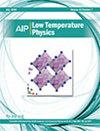叶酸及其类似物过敏症发生过程中蛋白质与配体结合的模型研究
IF 0.8
4区 物理与天体物理
Q4 PHYSICS, APPLIED
引用次数: 0
摘要
叶酸(FA)在各种新陈代谢过程中发挥着重要作用,包括 DNA 的合成和修复、细胞分裂、红细胞的生成和胎儿发育。然而,对叶酸及其类似物过敏会导致各种症状表现,包括呼吸急促、皮疹、瘙痒、荨麻疹、肿胀、胃肠功能紊乱、心动过速和过敏性休克。对 FA 及其类似物过敏的机制尚不十分清楚。不过,众所周知,人血清白蛋白(HSA)是许多物质和药物的主要药代动力学效应器,其中包括 FA 及其类似物,如 5-甲基四氢叶酸(5-MTHF)、四氢叶酸(THFA)和甲氨蝶呤(MTX)。HSA 可与这些化合物相互作用,影响它们的分布和代谢。本研究旨在研究 HSA 与四氢叶酸及其类似物之间形成的非共价复合物的能量和拓扑特征,以便更全面地了解超敏反应的潜在机制。分子对接法用于寻找蛋白质-配体复合物中能量最有利的构象,并根据其最低结合能对几何结构进行评分。HSA 的三维结构(PDB ID:1AO6)是从蛋白质数据库中获取的,被用作对接目标。配体(FA、5-MTHF、THFA 和 MTX)的结构是从美国国立卫生研究院的开放式化学数据库 PubChem 中下载的。使用 Proteins Plus 测定了结合口袋的表面积、体积和深度。使用 PoseView 和 DoGSiteScorer 网络工具鉴定了 HSA 与配体之间的非共价相互作用。结果表明,疏水相互作用和氢键主要稳定了所有研究的 HSA 配体复合物。分子对接分析表明,HSA 与亚域 IB、IIA 和 IIIA 中的配体结合,结合能小于 -10.0 kcal/mol。确定新抗原结构(HSA 与配体的复合物)中的特定结合位点对确定这些抗原的表位与 IgE 抗体或免疫细胞受体的活性位点的能量结合非常有价值。本文章由计算机程序翻译,如有差异,请以英文原文为准。
Model study of the protein-ligand binding in the development of hypersensitivity to folic acid and its analogs
Folic acid (FA) plays a vital role in various metabolic processes, including synthesis and repair of DNA, cell division, the production of red blood cells, and fetal development. However, hypersensitivity to FA and its analogs can occur, leading to various symptomatic manifestations, including shortness of breath, skin rashes, itching, hives, swelling, gastrointestinal disturbances, tachycardia, and anaphylaxis. The mechanism of hypersensitivity to FA and its analogs is not well understood. However, it is known that human serum albumin (HSA) serves as a major pharmacokinetic effector for many substances and drugs, including FA and its analogs such as 5-methyltetrahydrofolic acid (5-MTHF), tetrahydrofolic acid (THFA), and methotrexate (MTX). HSA can interact with these compounds, affecting their distribution and metabolism. The study aimed to study the energetic and topological characteristics of the non-covalent complexes formed between HSA and FA and its analogs in order to obtain more complete information about the potential mechanisms involved in hypersensitivity reactions. Molecular docking was applied to search for the most energetically favorable conformations of the protein-ligand complexes and score the geometries based on their lowest binding energy. The 3D structure of HSA (PDB ID: 1AO6) was used as the docking target, which was obtained from the protein database. The structures of the ligands (FA, 5-MTHF, THFA, and MTX) were downloaded from PubChem, an open chemistry database at the National Institutes of Health. The surface area, volume, and depth of the binding pocket were determined using Proteins Plus. The identification of non-covalent interactions between HSA and the ligands was carried out using the PoseView and DoGSiteScorer web tools. It has been demonstrated that hydrophobic interactions and hydrogen bonds predominantly stabilize all the studied HSA-ligand complexes. Molecular docking analysis revealed that HSA binds the ligands within subdomains IB, IIA, and IIIA, with a binding energy of less than –10.0 kcal/mol. Identifying specific binding sites within the new antigen structures (the complex of HSA with the ligands) can be valuable in determining the energetically favorable binding of epitopes from these antigens to the active sites of IgE antibodies or immune cell receptors.
求助全文
通过发布文献求助,成功后即可免费获取论文全文。
去求助
来源期刊

Low Temperature Physics
物理-物理:应用
CiteScore
1.20
自引率
25.00%
发文量
138
审稿时长
3 months
期刊介绍:
Guided by an international editorial board, Low Temperature Physics (LTP) communicates the results of important experimental and theoretical studies conducted at low temperatures. LTP offers key work in such areas as superconductivity, magnetism, lattice dynamics, quantum liquids and crystals, cryocrystals, low-dimensional and disordered systems, electronic properties of normal metals and alloys, and critical phenomena. The journal publishes original articles on new experimental and theoretical results as well as review articles, brief communications, memoirs, and biographies.
Low Temperature Physics, a translation of the copyrighted Journal FIZIKA NIZKIKH TEMPERATUR, is a monthly journal containing English reports of current research in the field of the low temperature physics. The translation began with the 1975 issues. One volume is published annually beginning with the January issues.
 求助内容:
求助内容: 应助结果提醒方式:
应助结果提醒方式:


